
We're all working together;
that's the secret.

Soda Feldspar
In ceramic bodies, the main vitrifying (fluxing) agent is feldspar. The majority of white warebodies contain good proportions of feldspar. It acts as a flux. In the ceramic industry, the flux is defined as that portion of the body which develops glass phase. This is provided mostly by feldspar. The amount of flux in a ceramic body should be only in such a proportion as to develop the desired amount of vitrification. If an excess of flux is added, the fired body becomes very glassy and consequently, brittle.
Sodium Feldspar is generally used for three purposes:
The glass and ceramic industries are the major consumers of feldspar and account for 95% of the total consumption.
Feldspar is generally used for Ceramics, Glass, Electrodes
We produce SODIUM FELDSPAR (NA-SPAR) in forms of :

| Sodium Feldspar | SF/01 | |
|---|---|---|
| Silica | SiO2 | 68% ( + 1% ) |
| Alumina | Al2O3 | 18% ( + 1% ) |
| Sodium Oxide | Na2O | 9% ( + 1% ) |
| Potassium Oxide | K2O | 1.50% ( + 0.5% ) |
| Titanium Oxide | TiO2 | Nil |
| Calcium Oxide | CaO | 0.50% |
| Magnesium Oxide | MgO | Traces |
| Ferric Oxide | Fe2O3 | 0.08% ( + 0.05% ) |
| Loss On Ignition | LOI | 0.40% |
Standard Packing available in 50 kg HDPE bags and 1or 1.25 m t Jumbo bags with liner inside , or as per customer requirements.
